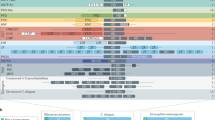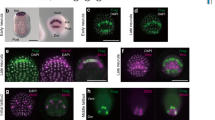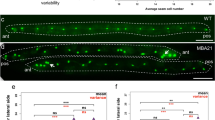Abstract
IN Caenorhabditis elegans, cell–cell communication is required to form a simple pattern of sensory ray neurons and cuticular structures (alae). The C. elegans pal-1 gene initiates one developmental pathway (ray lineages) simply by blocking a cell–cell interaction that induces an alternative pathway1. Here we show by mosaic analysis that pal-l+ acts by preventing specific cells from responding to inductive signals. The results indicate that although cell signals play a critical role in generating this pattern, they do not provide spatial information. Instead, signals are sent to many, if not all, of the precursor cells, and the ability to respond is spatially restricted. This patterning strategy thus differs from many well known models for pattern formation in which localized inductive signals influence a subset of cells within a field. We find that pal-1 encodes a homeodomain protein and so is likely to regulate transcription. The pal-l+ protein could block the response to cell signals either by repressing genes involved in signal transduction or by acting directly on downstream genes in a way that neutralizes the effects of the intercellular signals. Genetic experiments indicate that one candidate for such a downstream gene is the Antennapedia-like homeotic selector gene mab-5.
This is a preview of subscription content, access via your institution
Access options
Subscribe to this journal
Receive 51 print issues and online access
$199.00 per year
only $3.90 per issue
Buy this article
- Purchase on Springer Link
- Instant access to full article PDF
Prices may be subject to local taxes which are calculated during checkout
Similar content being viewed by others
References
Waring, D. A. & Kenyon, C. Cell 60, 123–131 (1990).
Sulston, J. & Horvitz, H. R. Devl. Biol. 56, 110–156 (1977).
Sulston, J. & White, J. Devl. Biol. 78, 577–597 (1980).
Kenyon, C. Cell 46, 477–487 (1986).
Austin, J. & Kimble, J. Cell 51, 589–599 (1987).
Costa, M., Weir, M., Coulson, A., Sulston, J. & Kenyon, C. Cell 55, 747–756 (1988).
Horvitz, H., Sternberg, P., Greenwald, I., Fixsen, W. & Ellis, H. Cold Spring Harb. Symp. quant. Biol. 48, 453–463 (1983).
Hedgecock, E., Culotti, J., Hall, D. & Stern, B. Development 100, 365–382 (1987).
Sulston, J., Schierenberg, E., White, J. & Thomson, J. Devl. Biol. 100, 64–119 (1983).
Rosenbluth, R., Cuddeford, C. & Baillie, D. Genetics 109, 493–511 (1985).
Burglin, T. R., Finney, M., Coulson, A. & Ruvkun, G. Nature 341, 239–243 (1989).
Scott, M. P. & Carroll, S. B. Cell 51, 689–698 (1987).
Fire, A. EMBO J. 5, 2673–2680 (1986).
Krause, M. & Hirsh, D. Cell 49, 753–761 (1987).
Author information
Authors and Affiliations
Rights and permissions
About this article
Cite this article
Waring, D., Kenyon, C. Regulation of cellular responsiveness to inductive signals in the developing C. elegans nervous system. Nature 350, 712–715 (1991). https://doi.org/10.1038/350712a0
Received:
Accepted:
Issue Date:
DOI: https://doi.org/10.1038/350712a0
This article is cited by
-
Conservation of ParaHox genes' function in patterning of the digestive tract of the marine gastropod Gibbula varia
BMC Developmental Biology (2010)
-
Features of the ancestral bilaterian inferred from Platynereis dumerilii ParaHox genes
BMC Biology (2009)
Comments
By submitting a comment you agree to abide by our Terms and Community Guidelines. If you find something abusive or that does not comply with our terms or guidelines please flag it as inappropriate.



